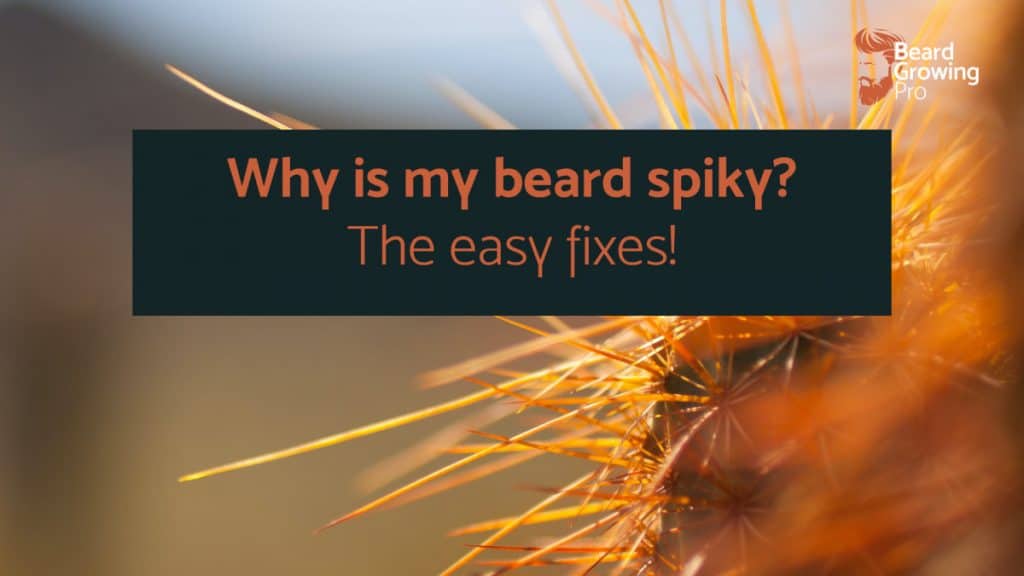As you are growing your beard you may find that it is very spiky. The spiky nurse comes from a range of issues and properties of the beard but it is normally your significant other who notices how spiky your beard is. Beard hairs are strong and thick and can easily poke and penetrate into the skin like a needle. In this article, we can go over all of the secret fixes that you can use, and I have used, to make my beard less spiky so that it is softer to touch and doesn’t cause any annoyance to your significant other.
Your beard is spiky because it is short. Growing out your beard a few more millimetres and using a beard softening solution like a beard conditioner or Beard butter will mean your beard gets less spiky over time. You can also use some products such as coconut oil after showering to soften the pointy ends of your beard.
Let’s take a look at why your beard is spiky and in the second section I will talk about all of the fixes for your sharp and spiky beard.
Article Contents
Why your beard is so sharp
Your beard may be sharp and spiky for a number of different reasons. One of the most likely reasons your beard is spiky is because it is short. Short beards are much more prone to being spiky just because of the length of the hair poking out of the skin and its inability to flex. But, they could be a number of other issues and we will go through each of them in this section.
Beard hairs are fat!
Beard hairs are fat and thick. The Beard hair is much thicker than any other type of hair on your body and is determined by the size of the hair papilla – the space where the hair grows in your skin. Essentially, the more space there is in the hair root the thicker the hair grows. Roughly, the hair on your face is about four times the size of the hair papilla in the male scalp.
It is the structural rigidity that these fat hairs possess which makes them particularly spiky. If you have recently shaved the hair may be thicker than is long and this creates the perfect amount of structural integrity to be spiky when put under pressure.
You see, the longer the Beard hair becomes the more likely it is to twist and buckle out of the way when pressure is put on top which means that the sensation is less spiky when touched.
It is short – pricking beard
As beard hairs emerge from your face they are anchored into your skin via the hair root. Along with the fatness of the beard hairs that we talked about above, this anchoring into your skin provides the perfect amount of strength to resist any buckling or movement.
Because the Beard hair is short and it is unable to move out of the way as it is anchored into the skin, the sensation to someone who touches the hair is that is prickly all spiky.
If you have recently trimmed your beard hair you will notice that within about a day your beard becomes particularly spiky. Not only is it because the beard is short but also the act of trimming or cutting the hair can make the ends of the hair spiky.
Let’s take a look deeper look at that aspect now.
Trimming – sharp ends
If you are trimming regularly, you may notice that your beard becomes particularly spiky soon after trimming.
This is because the hairs have been trimmed into a needle like point.
As beard hairs grow they naturally taper to a point. If you trim a hair the natural taper gets cut at an angle and replaced with a dead stop or a needle like point. As soon as you trim touched the ends of the trimmed hairs and you’ll notice that they are significantly prickly and spiky.
This effect will die down over time because the ends of the Beard hair will become weathered and no longer as well defined on the trimmed end of the Beard hair. With a little bit of patience and some Beard balm or leave in conditioner you’ll find that you’ll quickly be able to recover the spiky hairs so that they are not as spiky on the ends.
It is dry
Dryness is one of the most damaging properties your beard can have. Dryness causes your beard to look dull and brittle. If your beard has not received any particular moisturising care over the last couple of weeks you run the risk of it breaking more often and also being less flexible when touched.
There are a huge number of reasons why beard can dry out:
- UV light
- cold dry conditions
- hot dry conditions
- over shampooing
- excessive use of heat tools
- wind
- saltwater
- and much more
You’ll notice that all of these drying environments are found normally in everyday life. This is white particularly important to use products to replenish the moisture in your beard.
The good news is that there is a ton of different options for combating a dry beard and we will go through them in the next section, below.
Spit ends
Lastly, poorly maintained and dry beards can end up with a significant number of split ends. Dry beards are much more likely to split at the ends which can increase the perceived spikiness and make the Beard much more wiry.
Although the underlying cause of each type of beard split ends is the same (dryness and weathering) the way that the hair responds to splitting depends on the hair structure and how far up the hair the damage progresses.
There are three main types of split ends:
- snake tongue – this looks like a snake tongue where it is equally forked at the end of the hair. In other words one hair turns into two equal sections at the end forming a Y.
- Complete removal of the outer cuticle – this is where the beard hair looks as if it has been stripped like a wire is stripped of its outside plastic coating. This is where the complete outer layer of the hair is removed and all that remains is the inner section without any protection.
- Branching – this is where the hair has undergone several individual splits and it resembles a tree. It could be that one side of the hair has more splits than other and this creates an unbalanced branching of cortical cells. This shows that you have relatively advanced beard hair splitting and you should consider a deep hydration treatment or a serious trim up as quickly as possible. Perhaps branching is caused by exposure to harsh weathering so if you work outside or in a harsh environment you may see this more than the average person.
All of these different types of beard hair splits are bad and need to have urgent treatment to make sure they don’t further damaged the hair or cause it to become brittle and easier to damage through brushing.
Now, let’s take a quick look at all of the things that you can do to stop your beard from spiky. This list contains things that I wish I’d known when I first started growing a beard!
How do I keep my beard from being spiky?
Use all, or a combination, of these methods for stopping your beard from becoming spiky. Sometimes it’s as easy as waiting for your beard to grow while other times you need to be more proactive and test a range of different products and maintenance routines. You may actually be using all of the right products but just not in the right order or at the appropriate time relative to washing your beard. Approach this section with a sense of experimental inquisitiveness and you will be able to find the perfect solution for your spiky beard.
Grow it out
The first thing that you should do is look at the length of the beard and consider if growing it out will stop it from being so spiky.
As your beard gets longer and longer it will be able to bend and adapt to any force which is placed upon the shaft of the hair. When beard hairs are longer they are able to bend and flex and get out of the way of any external force which is applied which to an external toucher feels significantly less spiky.
In my own personal experience I noticed a significant softness after about a month of growth. This means that my beard was approximately half an inch long. If you want to keep your beard shorter than about half an inch there are some products on the market which enable you to hydrate your beard and stubble more so that it feels less spiky when touching it.
Good quality trimmers
If your beard feels particularly spiky after trimming it may be that your trimming blades, or your scissors, need to be replaced with a sharper set or sharpened.
As a general of thumb Beard trimmers, or their blades, need to be replaced every 12 months of regular use. Because trimmers rub against each other so quickly they are prone to dulling quicker than scissors.
Buying a good set of quality beard trimmers and replacing the blades. Your beard from getting as spiky. Essentially, we want to make sure that the beard is not cut at an angle while the beard trimmer is passing over the surface of the beard but rather that it cuts the hair perfectly perpendicular to the direction of the hair growth.
Check out my other article – best beard trimmer for thick course hair, five insider picks – for a complete run down of some of the best trimmers on the market that you can be sure have enough power and precision for cutting even the most thick of beards.
Coconut oil
Coconut oil is fantastic for hair because it has been well documented to seek under the hair cuticle’s which can be made more efficient using the application of heat.
Once the coconut oil has seeped to the inside of the hair it is able to nourish and protect the strength of the inner core.
To use coconut oil effectively all you have to do is soften the oil and apply throughout their hair and leave in for at least 20 minutes. Simply washing it out with a mild shampoo afterwards is a fantastic way of doing a dehydration treatment which you can do at home.
Vitamin E oil
Vitamin E is a fat-soluble nutrient which you can either eat or apply topically to the surface of your beard hair.
According to some, using a vitamin E oil regularly can help replenish the shine that can be lost due to beard damage and aging of the hair. Vitamin E oil can also stop beard oils becoming rancid through oxidation and dramatically increases the shelf-life of the beard oil. So if you are making your own oil you should consider using a little bit of vitamin E oil. This is particularly important if you are making a big batch and it will sit around for a few months before you open a new bottle.
Most of the claims that follow vitamin E around is dues to its anti-oxidant properties (why it preserves beard oils). Here are a few things that vitamin E can do to help your beard:
- Increase shine – There is limited scientific evidence that vitamin E restores shine but there is plenty of anecdotal evidence from manufacturers of hair products and their customers. It probably won’t hurt to give it a go for your beard!
- Prevent hair fall from beard – there is a very small study that looked at the ability of vitamin E to prevent hair loss. More research is needed but the results from the study showed a small improvement of hair growth over the placebo control.
- Heathier skin – Vitamin E could help you maintain healthy skin underneath the beard due to its antioxidant effects. This property could help reduce the amount of oxidative stress that could cause the hair follicles to break down.
Vitamin E can be found in beard care products, but you can also obtain vitamin E from your diet. Foods with a high level of vitamin E are leafy greens, nuts and seeds, vegetable oil and fortified cereals.
Shea butter
Shea butter is extracted from the nuts of the Shea tree. The raw form has an off white color and is a solid at room temperature. Shea trees are found in Africa and has been used for centuries for it’s medicinal properties.
The shea butter has so many awesome properties that it would be silly not to buy a beard butter that has this as one of its main components:
- It can help you beat beardruff – In 2018 a study found that when used in combination with other products it helps reduce flakes.
- It may help hair get stronger – Similar plant-based butter has been shown to make hair much more resistant to breakages
- It is antibacterial and antifungal – if your beard is smelling or you have some issues with a dirty beard. Shea butter will help fight off the bacteria that are in your beard. Want more about beard bacteria? Check out this article all about beard bacteria.
- Can add slight sun protection to your beard hair – If you live in a sunny and hot environment shea butter ats an extra layer of sun protection that has been estimated to provide a 3 – 4 SPF protection.
These properties mean that it is amazing to use as often as you want on your beard! These options are individual product and ingredient solutions. However, some beard spikiness needs to be resolved with products which have been especially formulated for beards.
Let’s look at the best beard products for stopping beard prickliness.
Products
When I first started grown a beard I was relatively sceptical of anyone trying to force any sort of beard product on me. However, over time I have found that a combination of the beard products listed below have helped me produce a softer and more manageable beard and it hasn’t cost as much as I thought it would cost. I’m even making my very own Beard balm which I can make a fraction of the price of commercially available balms.
Beard oil
Beard oil seems to be the solution for a range of different beard ailments. However, for spiky beard is a beard oil applied immediately after a nice hot shower can lock in moisture to the hair and cause it to be softer and easier to manage.
Beard oil can be used from the stubble stage and will provide your beard hair and skin with a range of different benefits which will lay the perfect foundations if you decide to grow a long beard.
Beard butter
Beard butter is the next level of hydration and conditioning if you find that beard oil is not quite cutting the mustard.
Beard butters are incredible as they contain a natural butter, such as Shea butter or cocoa butter, with can hydrate, condition, and repair your beard hair. It creates a softness to your beard which is unparalleled by any other type of product and it will even leave your beard smelling great if you choose a beard butter with essential oils that you love.
The best time to apply beard balm is after your beard has received a deep shampoo and conditioning and it is dry. Use medium heat on your hairdryer to dry your beard and, just as it is becoming dry, you can use beard butter. It is used to lock in the moisture from the shower.
But be careful when applying it to freshly washed hair – wet hair is easier to break.
You can also apply beard butter later on in the day if you are finding that your beard hair is still a little bit dull and you want to bring it back to life a little bit more! If your beard is still looking a little bit worse for wear and not sitting the way you want it to you will have to apply a wax or a balm!
Beard conditioner
Lastly, if you are finding that none of the above products are working for your beard you can opt to use a beard conditioner.
A beard conditioner is like a hair conditioner but specifically formulated for your beard. It has a range of natural oils and butters in it so that it hydrates your beard more efficiently. Beard oil, and butter all have the capacity to condition your beard but they are not specialised for the task of deeply hydrating your skin and beard.
You should consider buying a beard conditioner if you are really struggling to stop your beard from being very spiky!
Summary
In this article, we have gone over all of the reasons why your beard may be particularly spiky and the products and interventions you can use to soften it up.
As long as you are willing to trial a different number and combinations of approaches I’m in no doubt your be able to quickly soften your beard so that is no longer as spiky.



